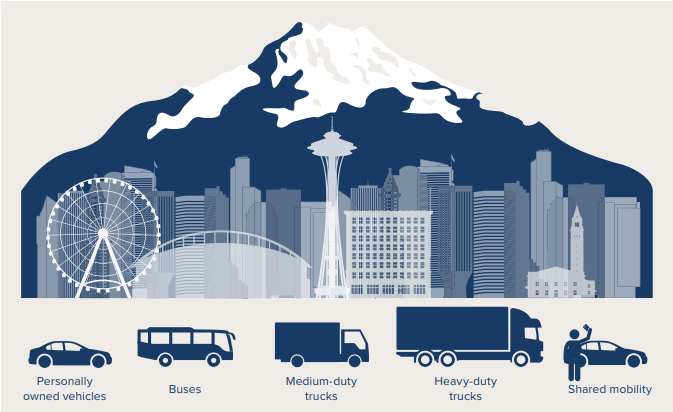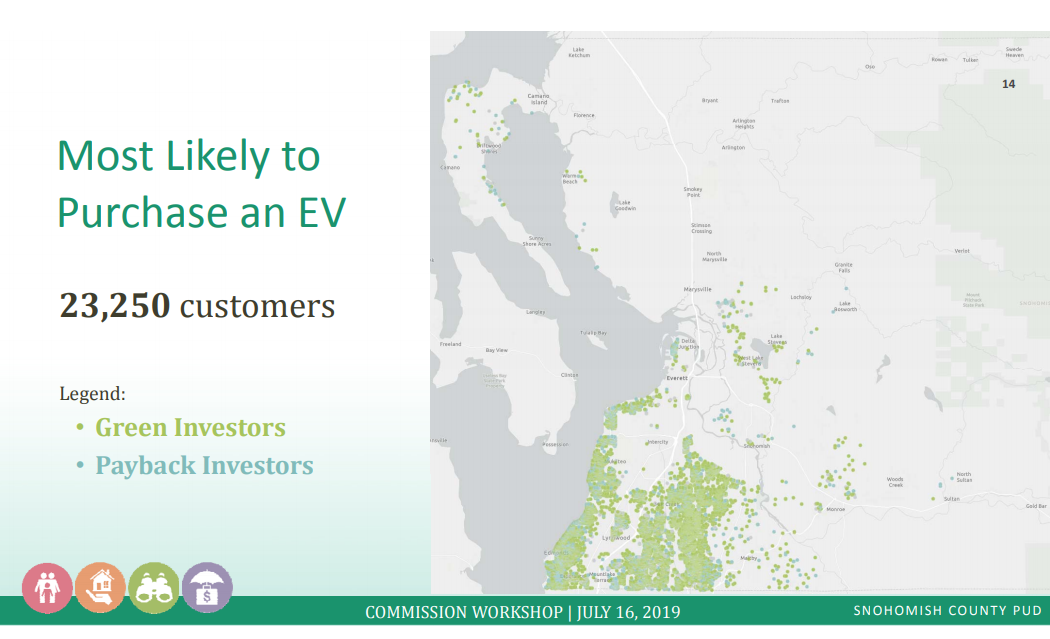Electric Vehicle Adoption
For Northwest Utilities, Proper Planning is Essential

GridFWD 2019, hosted by Grid Forward (formerly Smart Grid Northwest), convened energy service professionals from across the Pacific Northwest in Seattle to focus on advanced solutions to modernize the regional energy system. In a series of articles, Cadmus presents some key themes that emerged regarding innovations in grid decarbonization and the different pathways, priorities, and solutions discussed as next steps in moving decarbonization and grid modernization forward.
By Joan Wang
Electric vehicles (EVs) bring perks and challenges to the utility industry. On the upside, they create a new end-use load for utilities that increases electricity sales and—in regions like the Pacific Northwest that are able to generate electricity from relatively clean fuel sources—reduces net carbon emissions at the same time. As more and more EVs hit the road, they offer a potential avenue to decarbonizing the Northwest—but only if they are managed effectively.
Responding to a Customer-Driven Trend
Northwest customers are steadily driving EVs and several major public utilities in Washington state reported at the GridFWD conference that they are now catching up to this customer preference. This dovetails nicely with the push for decarbonization in the region. Earlier in 2019, Washington committed to a carbon-free electricity supply by 2045 in the Clean Energy Transformation Act. The Washington State Department of Commerce highlighted that this act will “allow the state to replace fossil fuels in other end uses, especially transportation, and achieve its long-term climate goals.”
The transition to EVs goes hand in hand with decarbonization, and utilities play an important part in this transition. By nature of the business, utilities must supply power to whomever needs it, whenever they need it. Accommodating new end uses impacts all parts of the utility business and poses interesting challenges. As a new end use, EVs require more electric power to be generated, transmitted, and distributed to their charging stations. Utilities must take care to understand how this end use impacts its business to adequately manage this transition.
Northwest utilities are more than cognizant of the customer trend toward EVs and its potential impacts on the grid and are taking action now to ensure the increased demand does not harm the grid, but rather, ultimately becomes an asset.

Working Together
Utilities recognize a cross-functional management approach is necessary to accommodate the rapid increase in EVs. At the GridFWD conference, Snohomish Public Utility District (PUD) and Seattle City Light both shared that they created cross-functional teams to tackle transportation electrification.
Working toward its “Vision of the Future”, Snohomish PUD created the District Cross-Functional Work Group for EVs that spans distribution engineering, load forecasting, customer programs, government affairs, and corporate communications. In recent months, it has revised its new service questionnaire to include questions about EV use and updated its website to highlight rebates on all-electric Nissan LEAFs.
Seattle City Light recently developed a transportation electrification strategy that calls for investing in charging infrastructure, improving the customer experience (such as time of day and fleet charging rates that encourage electric transportation, as well as a streamlined interconnection and service upgrade process), and preparing for heavy-duty electrification. As this strategy impacts various utility functions from physical infrastructure and ratemaking to customer service, Seattle City Light now has a cross-functional electrification division to help with implementation. In addition, Seattle City Light is also actively working with outside entities such as King County Metro, the Port of Seattle, and Washington State Ferries, all of whom are crucial partners in heavy-duty electrification.
Keeping Track of a Moving Target
One immediate and necessary action for utilities is to understand where and when the new electric loads are happening. EV growth must be accounted for and periodically re-examined in utility planning cycles. According to a Smart Electric Power Alliance report, “many utilities do not incorporate [EV] load growth into their distribution planning process. Of those utilities that do, it is through less sophisticated forecasting methods that do not take into account the propensity for clustering or fleet electrification.”
It is important to remember that transportation electrification comes in various shapes and forms: in addition to privately owned electric cars, infrastructure will need to support increasing numbers of electric buses, freight carried by electric trucks, and more. Seattle City Light is preparing its transmission and distribution system to accommodate any type of charging loads added to the grid. Seattle City Light’s Energy Innovation and Resources Officer, Emeka Anyanwu, emphasizes that, to support the electrification goals of its industrial customers, Seattle City Light must adjust its processes and operations to “move as fast as they [customers] want to move.”
At GridFWD, Snohomish PUD’s CEO and General Manager, John Haarlow, shared that Snohomish PUD created distribution system capacity heat maps to understand demand-related changes to its grid system. Accounting for new EV load growth in aggregate and distributed ways is crucial to effective identification of capacity excess or constraints. On an aggregate level, Snohomish PUD accounted for EVs in a load forecast in its draft 2019 IRP. To proactively plan for new charging loads at the distribution level, Snohomish PUD mapped out the locations of customers most likely to purchase an electric vehicle (Fig. 2).  Figure 2 Snohomish County PUD forecast of customers most likely to purchase an electric vehicle. Source: Snohomish County Public Utility District.
Figure 2 Snohomish County PUD forecast of customers most likely to purchase an electric vehicle. Source: Snohomish County Public Utility District.
Transportation electrification is in the fast lane within the Northwest region, and utilities play a crucial role in facilitating its development. Anticipating growing commercial uses for electric fleets, Seattle City Light, Pacific Power, Portland General Electric, and Puget Sound Energy are partnering with other utilities on the West Coast to sponsor a study to determine how Interstate 5 can be “equipped with sufficient charging to support electric long-haul trucks.” Needless to say, transportation electrification shows no sign of slowing down.
More GridFWD Insights
In Transition to Decarbonization, Energy Efficiency Stakeholders Embrace New Paradigms
Learn MoreThe Role of Wholesale Markets in Grid Decarbonization